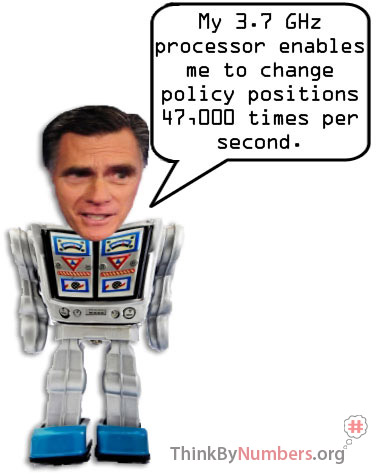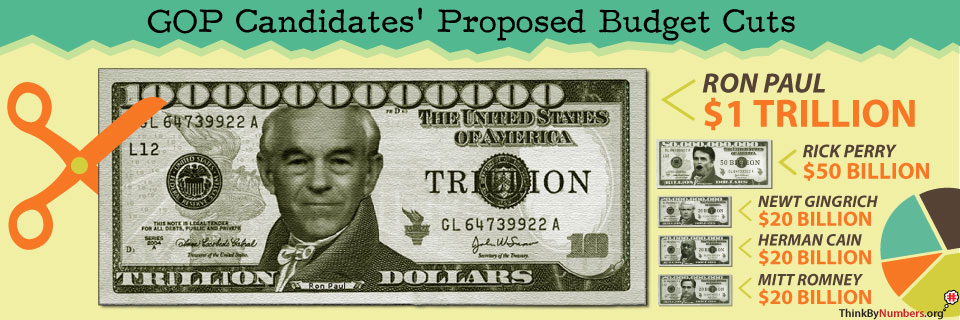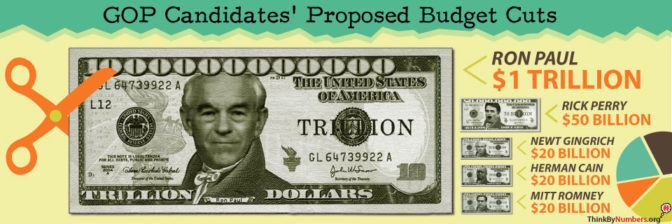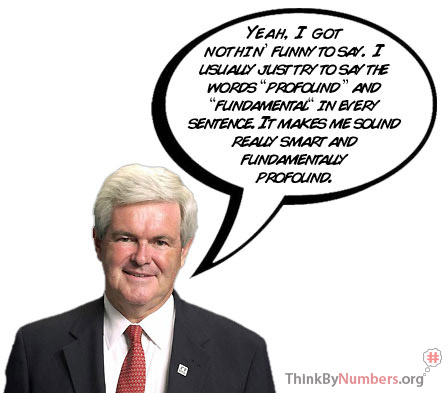GOP Candidate Ron Paul has produced a detailed budget containing over $1 trillion in first-year reductions. Mitt Romney, Rick Santorum, and Newt Gingrich have only indicated that they would attempt to repeal Obamacare saving an average of $20 billion a year.
Why Do the Candidates’ Budget Plans Matter?
The only way that a president can noticeably affect the everyday lives of all Americans is by raising or lowing their standard of living. This is accomplished through their influence over the real tax rate. The real tax rate encompasses all normal forms of taxation, but it also includes a hidden tax known as inflation.
All of the Republican candidates have detailed plans for modifying the tax code. But saying you’re going to cut taxes without cutting spending correspondingly is sneaky. If you cut taxes, but maintain the same level of spending, then you have to either borrow or print the resulting budget shortfall. Borrowing the money is worse than paying with taxes immediately, not only because we’ll have to pay it back in a future when the government’s fiscal situation is predicted to be far worse than is today, but we’ll also have to pay a bunch of interest on top of that.
The alternative to borrowing is to have the Federal Reserve fire up the printing press. The FED creates trillions of new dollars out of thin air and give it to the government through the purchase of treasury bonds. The effect of this is identical to the effect of criminal counterfeiting. If one doubles the money supply without a corresponding increase in GDP, the long-term result is that everyone’s paycheck can only buy half as much.
So using the magical money machine to pay the bills just shifts the tax burden to an inflation tax. According to the Consumer Price Index, inflation is only about 3.5%. However, the real rate of inflation is currently almost 10%. The inflation tax, while largely ignored, hurts middle-class and low-income Americans the most. This is because inflation is flat tax which doesn’t tax the poor at a lower rate the way our progressive income tax system does. In fact, it’s somewhat regressive because the loss in value is delayed. When the new money is initially created, price inflation hasn’t set in yet. The first people who get to spend the new money are generally giant financial institutions. By the time it filters down the average Joe, it’s already lost a lot of it’s value.
So the only way a president can change the real tax rate is by increasing or decreasing government spending. Therefor, the only thing about a candidate that’s guaranteed to significantly impact your life is not whether they think gay people should have the right to suffer through the institution of marriage. It’s not whether or not their religion’s doctrine includes magic underwear. It’s not even their tax plan. It is only the candidates’ positions on spending that is guaranteed to directly affect your everyday life by increasing or decreasing your standard of living.
But does a president really have any control over spending?
After all, isn’t the level of spending set by the congress? This is generally true, but the president does have a number of very powerful means of controlling the budget:
- The Power to Appoint the Chairman of the Federal Reserve – This power enables the president to choose a chairman who would refuse to monetize the debt. In this case, the government wouldn’t be able to print new money out of thin air. Then congress couldn’t spend any more than tax revenues or borrowing permits.
- The Power to Veto – The president has the power to veto bills containing spending which he opposes. Congress would then have to override this veto with a two-thirds majority both houses.
The Candidates Compared
We know that President Obama stands shoulder to shoulder with our nation’s drunken sailors on spending, but what about the potential Republican nominees?
 Mitt Romney
Mitt Romney
(a.k.a. Mormobot 5000)
Specific Cuts = $20 Billion
Romney wants to repeal Obamacare (which is very similar to Romneycare aside from the fact that Romneycare covered abortions). As stated before, this would save $20 billion a year.
Other than that, this is the maximum level of specificity from his programmers:
“Mitt Romney will bring fiscal restraint to Washington by placing a hard cap on federal spending to force our government to live within its means and put an end to deficit spending.
Mitt will also curb federal spending by repealing Obamacare, the federal takeover of health care that is scheduled to cost taxpayers one trillion dollars over the next ten years. He will also focus on eliminating wasteful government spending and right-sizing the federal government to save taxpayer dollars. 00010101.”
The Romney Record on Spending
If we’ve learned anything from the vast disparity between George W. Bush’s fiscal rhetoric and fiscal record, it’s that Romney’s gubernatorial record might be a better indicator of what we could expect from a Romney federal budget. Under Mr. Romney, state spending went from $22.3 billion to $28.1 billion, an annual increase of 6.5 percent. This is twice as much as the average 2.9% average statewide budget increase.
So, if his record is any indication, we shouldn’t expect too much from a Romney presidency in the way of cutting the federal budget.
Image Source (Below)
 Ron Paul
Ron Paul
(a.k.a. Dr. No)
Specific Cuts = $1 Trillion
From his complete detailed and itemized budget:
<
p style=”text-align: justify;”>“The Plan to Restore America cuts $1 trillion in spending during the first year of Ron Paul’s presidency, eliminating five cabinet departments (Energy, HUD, Commerce, Interior, and Education). It abolishes the Transportation Security Administration and returns responsibility for security to private property owners. It also abolishes corporate subsidies, stops foreign aid, ends foreign wars, and returns most other spending to 2006 levels.
CUTTING GOVERNMENT WASTE:
Makes a 10% reduction in the federal workforce, slashes Congressional pay and perks, and curbs excessive federal travel. To stand with the American People, President Paul will take a salary of $39,336, approximately equal to the median personal income of the American worker.”
Image Source (Above)
The Paul Record on Spending
Paul’s congressional record consists of a long list of votes against federal spending.
- Voted against the Medicare Prescription Drug Act
- Voted nine out of nine times against raising his own pay
- Voted against No Child Left Behind
- Voted against the subsidy-laden 2002 Farm Bill
- Voted against the 1998 and 2005 Highway bill, only 1 of 9 to vote against the pork-filled 2005 bill
- Voted against the Stimulus, TARP, auto bailout, and Cash for Clunkers
- Voted against the Iraq War
Let’s look at how Ron Paul’s plan would affect the individual taxpayer. He wants to cut $4,000,000,000,000 over his 4-year term. Divide this number by 142,449,000 federal income tax filers and that comes out to an average of $28,080.23 in savings for each taxpayer. Alternatively, the $4 trillion should be divided by 307,006,550, the total US population. This would produce a 4-year savings of $13,029.04 per person.
Newt Gingrich
(a.k.a. Sorry, There’s Nothing Funny About Newt Gingrich)
Specific Cuts = $20 Billion
Like Cain and Romney, all his cuts would come from the repeal of Obamacare.
Other than that, he’s not too specific. From his website:
“Balance the budget by growing the economy, controlling spending, implementing money saving reforms, and replacing destructive policies and regulatory agencies with new approaches.”
The Gingrich Record on Spending
Gingrich’s fiscal record is mixed. During his time in Congress, he had an exemplary voting record on a lot of the top spending proposals:
- Voted NO on the Chrysler bailout in 1979
- Voted YES on the Gramm-Rudman balanced budget bill in 1985
- Voted YES on a balanced budget amendment (as part of the “Contract for America” effort that he led) in 1995
- Led the effort and voted YES to cut $16.4 billion from the budget in 1995.
- Voted YES on welfare reform in 1996
Gingrich has also been a vocal opponent of most of the big spending habits pushed by the White House and Congress over the past few years. He opposed the $787 billion stimulus proposal, the auto bailout, and Cash for Clunkers.
On the other hand, in 2003, when he urged “every conservative member of Congress” to support the Medicare drug benefit bill. He called it the “most important reorganization of our nation’s healthcare system since the original Medicare Bill of 1965.” The drug benefit now costs taxpayers over $60 billion a year and has almost $16 trillion in unfunded liabilities.
Notably in 2008, he also backed the $700 billion Wall Street bailout.
He’s also attacked those who oppose omnibus spending bills. These bills roll thousands of programs which may not pass on their own into massive one massive all or nothing bill that is more likely pass. In 1998, he derided a group of House conservatives by calling them the “the perfectionist caucus” for opposing a 4,000-page omnibus spending bill, adding that “those of us who have grown up and matured in this process understand after the last four years that we have to work together on big issues.”
Herman Cain
(a.k.a. Pizza Dude)
Specific Cuts = $20 Billion
Like all the other candidates, Cain wants to repeal Obamacare which would save $20 billion a year. But other than that, this is about as detailed as it gets:
“Nothing should be off the table. Every federal agency, every government program and expenditure must be reviewed and revised with a keen eye and a red pen.”
The Cain Record on Spending
It doesn’t exist. With no political record, Cain needs to be way more specific for voters to make anything close to an educated decision.
What is known is that Cain supported TARP, the government bailout of the financial industry. He even chastised those who opposed it.
On the other hand, Cain opposed the Democrats’ stimulus, saying, “The Obama-Reid-Pelosi cure for more national economic pain – more spending, more taxes and more socialism! That’s just more pavement for the road to perpetual debt.”
This sounds nice, but without significant specific spending cuts, Cain’s 9-9-9 tax plan will actually be a 9-9-9-9 plan. A 9% corporate tax, a 9% sales tax, a 9% income tax, and a hidden 9% inflation tax.

Rick Perry
(a.k.a. The Executioner)
Specific Cuts = $50 Billion
From his rock:
“Consolidating Department of Education funding for all elementary and secondary programs, reducing it by 50 percent, and returning the rest of the money to the states would save $25 billion in the first year. Reducing the portfolio of investments by government-sponsored enterprises like Fannie Mae and Freddie Mac would save $26.5 billion over ten years.”
The Perry Record on Spending
Like Romney, Perry’s real record is not one of fiscal restraint. Rick Perry came into office in December 2000. Texas general spending has risen from $29 billion that first Perry year to $41 billion by fiscal year 2011, which works out to an average annual increase of 3.5 percent. (Data from NASBO).
For some perspective, let’s look at Perry versus the average spending increases of governors in all 50 states over the last decade.
Here is NASBO data showing increases in state general fund spending between fiscal 2001 and fiscal 2011:
- Texas, Perry: $29 billion to $41 billion, a 41 percent increase.
- Total of 50 states: $506 billion to $651 billion, a 29 percent increase.
However, the Texas population has grown faster than the U.S. population, so let’s put these figures on a per-capita basis.
- Texas, Perry: $1,360 per capita to $1,598 per capita, an 18 percent increase.
- Total of 50 states: $1,774 per capita to $2,091 per capita, an 18 percent increase.
Perry is touting the “Texas Miracle” as a template for the rest of America, which is stuck in a rut of high unemployment and could certainly use some fresh ideas for how to create jobs. Texas has clearly fared better than most other states since the recession began at the end of 2007. Its unemployment rate is 8.2%, a full point lower than the national average. The housing bust in Texas was far milder than it was in other places. A strong energy sector kept state tax revenues from plunging the way they did in other states, which forestalled layoffs in state and local government. Additionally, the majority of the jobs created in Texas were government jobs. From the beginning of 2008 to the end of 2010, government employment in Texas increased by 7 percent, whereas it only increased 2 percent over the rest of the country. Private sector jobs in Texas only grew by 0.6% during this period.
So Perry’s record is perfectly mediocre. Like with Romney, we shouldn’t expect too much in the way of cuts if past is prologue.
The Verdict
So after examining the records and proposals of all the candidates, it appears that Ron Paul is the only candidate who intends to make balancing the federal budget a real priority. Based on the others’ records and proposals, it appears pretty likely that, under their administrations, we’re going to continue the status quo Washington spending spree.

Podcast: Play in new window | Download



